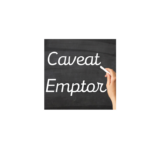Caveat Emptor … a Latin phrase meaning, “Buyer Beware.” For centuries buyers have been held to a standard of due diligence; do your homework before you buy or suffer the consequences.

Purchasing instructional materials is the single largest annual purchase a school district typically makes. To put it in context: school districts spend more on instructional materials annually than you paid for your house. A purchase that large certainly merits careful due diligence.
Before we purchase a house, we engage a realtor and spend weeks even months visiting multiple houses on the market. We compare the features of each house against our mental list of “must haves” and select the house that exhibits the largest number of our “must-haves.” Do districts exercise the same level of diligence before purchasing instructional materials?
Traditionally, reviewing instructional materials before the district makes its selection decisions is a task delegated to overworked educators. Teachers review the available materials at vendor fairs, in their “spare” time at school and at home, and during interminable selection committee meetings. The same process is relied upon despite the fact that instructional materials have become increasingly complex and difficult to review. So, when it comes to buying new materials, how does your district avoid making a (multi) million-dollar mistake?
Here are a few common mistakes districts make when purchasing instructional materials and some suggested solutions.
Mistake #1: Rushing to Select Instructional Materials
Many districts believe sooner is better when it comes to making a selection decision. Their goal is to complete their instructional materials selection process by early February or March. Some do this to ensure that the materials reach classrooms before school starts. However, most core materials are now available digitally, eliminating the need for a long delivery timeline. Other districts believe that state law requires school boards to approve materials by March or early April. In Texas, for example, districts must submit requisitions to purchase state-adopted materials to the Texas Education Agency by June 1st of the proclamation year. While publishers may impose a deadline for orders, most states do not require districts to purchase materials by a date certain.
It is not wise to rush your selection and review process. Most new-to-market materials are not completed until a few months before they are to be delivered. Publishers start selling the concept of a material long before the material is finally published. Similarly, in “adoption” states, publishers submit the content of their new materials for state and public review, while the product features and functionality are still being built. Districts that rely on the publishers’ claims or rely on the publicly available digital samples are relying on publishers’ promises of what the product will look like, do, and contain. While publishers may intend to develop all of the functionality promised, 11th-hour production impediments may prevent the final product from containing all of those features.
Bottom line: since most core instructional materials are available digitally, districts generally do not need to order materials as early as they used to. It is prudent to wait to make selection decisions until you have reviewed the available published products. Doing so will likely result in less disappointment and fewer purchased materials that go unused.
Mistake #2: Believing Publisher’s Alignment Claims
First, why is alignment so important? Teachers expect that the district-provided core materials are aligned to 100% of the state’s standards. If those materials are not 100% aligned, teachers may not teach all the knowledge/skills required by the standards. If students are not taught what the standards require them to know and be able to do, they are less likely to succeed academically. Teachers, as well as campuses and districts, are evaluated based on their students’ performance.
In sales presentations, publishers generally claim that their materials are “aligned to the [state standards].” After all, if they did not make such claims, districts would not purchase their materials. Having reviewed thousands of PreK-12 instructional materials, Learning List can state with certainty, that most materials are not as well aligned to the state standards as publishers claim.
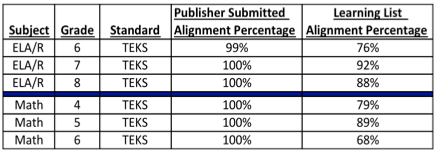
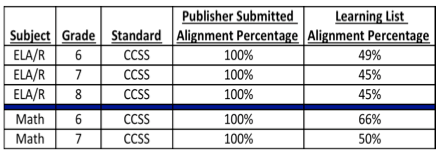
Bottom line: the alignment of your district’s instructional materials will inevitably impact students’ scores, which in turn will impact teacher evaluations and campus and district ratings. Therefore, it is crucial to know the alignment percentage of materials your district is considering purchasing. If your district decides to have teachers review the alignment of the materials being considered for adoption, it is important to have more than one teacher check the alignment of each material for each grade level. Why? Determining alignment is an inherently subjective endeavor. Having a few teachers working together to check the material’s alignment reduces the subjectivity of alignment determinations. This whitepaper discusses common alignment challenges and strategies for overcoming them.
If the district lacks the time or capacity to perform alignment reviews internally, Learning List’s low-cost subscription instructional materials review service provides access to independent alignment reviews of thousands of the most widely used PreK-12 instructional materials conducted by highly experienced, trained educators.
Mistake #3: Assuming Alignment is Consistent Across Grade Levels
It is easy to assume that the alignment percentage of a material for one grade level is reflective of the material’s alignment at all grade levels. Learning List’s alignment reviews tell another story.
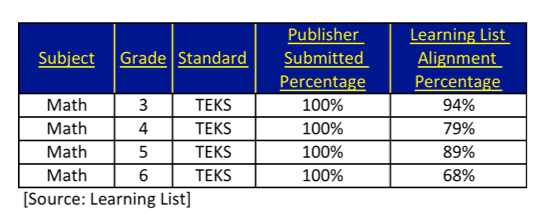
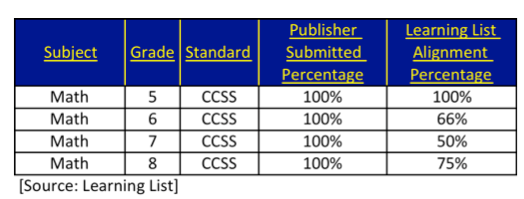
There are many reasons why the alignment of a material may vary significantly from grade level to grade level. A different author may have written the material’s content and/or a different person may have constructed the publisher’s correlation at each grade level. The material’s content may not progress in rigor at the same pace as the standards do. The material may not address a certain strand or domain that is emphasized more in one grade level than others.
Bottom line: to prepare students effectively to master the standards, teachers must know which standards the material is aligned to in each grade level so that they can adjust their instructional strategies accordingly. Do not assume that the alignment percentage at one grade level is representative of the product’s alignment at all grade levels, or even at all grade levels within a single grade span. If your district is going to purchase multi-grade level material, check the alignment of the material at each grade level.
Districts spend millions of dollars each year on new instructional materials. Basing purchasing decisions on incomplete materials will inevitably lead to disappointment and frustration. If you are considering new-to-market materials, prolong the review process to ensure that your district has reviewed the published edition that teachers will be using. One of the biggest predictors of a material’s impact on student learning is its alignment to state standards. Before purchasing a new material, be sure to have an independent verification of the material’s alignment to your state standards for each grade level you will be purchasing. Your teachers, students, and taxpayers deserve it.
